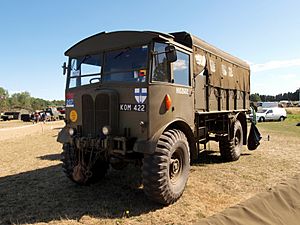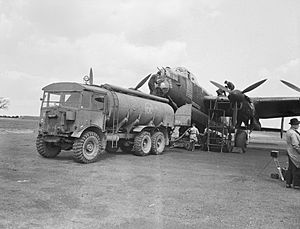AEC Matador facts for kids
Quick facts for kids AEC Matador |
|
|---|---|

AEC Matador, H102602
|
|
| Place of origin | United Kingdom |
| Production history | |
| Manufacturer | AEC |
| Produced | 1938-1945, 1953-1958 |
| No. built | 10,411 |
| Variants |
|
| Specifications | |
| Mass |
|
| Length |
|
| Width | 7 ft 10 in (2.39 m) |
| Height | 10 ft 2 in (3.10 m) |
|
|
|
| Engine |
|
| Drive | 4x4 |
| Transmission | 4F1R |
| Suspension |
|
| Maximum speed | 36 mph (58 km/h) |
| References | The AEC military vehicles |
The AEC Matador was a strong 4x4 truck. It was also used to pull big guns. The AEC built it in the United Kingdom. It was used by British and Commonwealth forces during World War II. AEC had made other trucks called Matador before this one.
What it Looked Like
The Matador truck looked quite special. It had a flat front and a gently curved roof. Its wheels were placed right at the corners. It had a flat area at the back for carrying things. This area was usually covered with a canvas or tarpaulin.
Because it was an artillery tractor, it carried gun crews. The wooden sides of the back area were fixed. They did not fold down. There was a small door on each side for the crew. Two bench seats were inside for the gun crew.
The driver's cab was made of ash wood and covered with steel. Like all artillery tractors, it had a powerful winch. This winch could pull up to 7 tons. A special version of the Matador was used as an armoured command vehicle.
AEC also made a bigger 6x6 version of the Matador. This one used parts from other AEC trucks. Both petrol and diesel engines were used in these larger trucks. A few 4x4 Matadors were also built with petrol engines.
How it was Used
About 9,000 Matador trucks were built. Some of them went to the Royal Air Force (RAF).
For the British Army, the Matador was very important. It was used to tow medium-sized guns. These included the 5.5-inch medium gun and the QF 3.7-inch AA gun. It was a useful vehicle and was even changed to carry a 25-pounder gun.

The RAF used Matadors as flatbed trucks to carry supplies. A 6-wheel Matador was also used as a refuelling tanker. It could carry 2,500 gallons of fuel. It also helped tow Short Sunderland flying boats when they were on land.
Six special Matador trucks were made into armoured flamethrowers. These were called 'Heavy Cockatrice'. The RAF used them to defend airfields.
During the North African campaign in 1942-1943, some Matadors were fitted with a 6-pounder anti-tank gun. This created the AEC Mk1 Gun Carrier "Deacon". The Canadian Army also used the Matador during World War II.
After the War
After World War II, many Matadors were used by civilians. They became recovery trucks, especially for buses. They were also used by showmen and general contractors. Their good off-road ability made them useful for forestry work too. Many were changed to have lifting cranes for towing other vehicles.
See also
- Bedford QLD - 3 ton general service truck four wheel drive, 4WD, introduced 1941.
- Austin K2/Y
- Canadian Military Pattern Field Artillery Tractor



